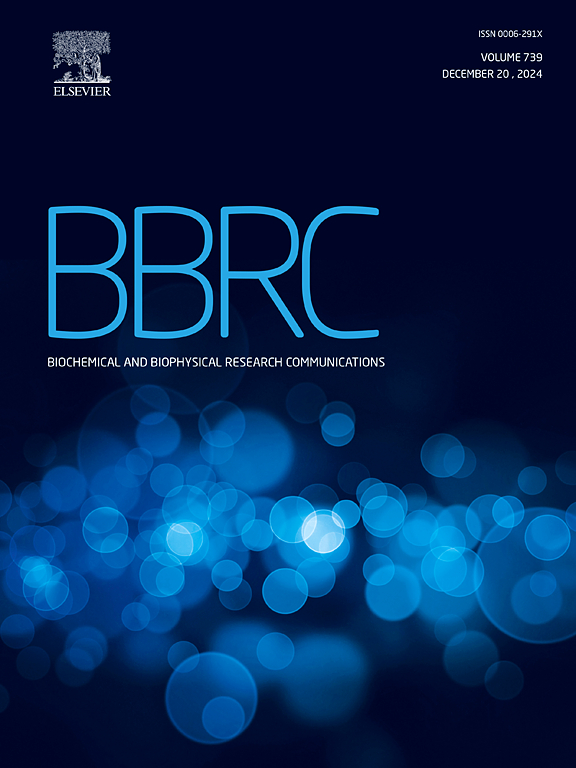Cell cycle-dependent radiosensitivity of CHO DNA repair mutants exposed to accelerated charged particles
IF 2.5
3区 生物学
Q3 BIOCHEMISTRY & MOLECULAR BIOLOGY
Biochemical and biophysical research communications
Pub Date : 2025-04-02
DOI:10.1016/j.bbrc.2025.151747
引用次数: 0
Abstract
The two primary DNA double-strand break (DSB) repair pathways, non-homologous end joining (NHEJ) and homologous recombinational repair (HRR), play crucial roles in determining radiosensitivity throughout the cell cycle. Our study investigated mechanisms underlying cell cycle-dependent radiosensitivity following exposure to accelerated charged particles in DSB signaling and repair-deficient CHO mutant cell lines. We confirmed NHEJ-deficient V3 cells exhibit hyper-radiosensitivity across all phases, while HRR-deficient 51D1 cells display increased sensitivity in the typically radioresistant S/G2 phase following X- and gamma-rays. Exposures to accelerated 290 MeV/n C-12 and 500 MeV/n Fe-56 ions induced complex DNA damage that was not fully repaired by either pathway, leading to increased cell killing. HRR-deficient cells exhibited higher relative biological effectiveness (RBE) values for cell killing in G1 and S and levels of chromatid-type chromosomal aberrations were higher in HRR-deficient cells. Additionally, impaired G2-phase checkpoint activation in HRR-deficient cells contributed to mitotic entry with unresolved DNA damage. Our findings suggest that charged particles produce complex lesions that require coordinated repair by both major DSB repair pathways, and disruption of either pathway leads to increased radiosensitivity.
暴露于加速带电粒子的CHO DNA修复突变体的细胞周期依赖性辐射敏感性
两种主要的DNA双链断裂(DSB)修复途径,非同源末端连接(NHEJ)和同源重组修复(HRR),在决定整个细胞周期的放射敏感性中起着至关重要的作用。我们的研究探讨了DSB信号和修复缺陷的CHO突变细胞系暴露于加速带电粒子后细胞周期依赖性辐射敏感性的机制。我们证实nhej缺陷的V3细胞在所有阶段都表现出高放射敏感性,而hrr缺陷的51D1细胞在X射线和伽马射线照射后的典型放射耐药S/G2期表现出更高的敏感性。暴露于加速290 MeV/n的C-12和500 MeV/n的Fe-56离子诱导的复杂DNA损伤不能通过任何途径完全修复,导致细胞死亡增加。hrr缺陷细胞在G1期和S期细胞杀伤表现出较高的相对生物有效性(RBE)值,并且hrr缺陷细胞的染色单体型染色体畸变水平较高。此外,在hrr缺陷细胞中,受损的g2期检查点激活有助于有丝分裂进入,并伴有未解决的DNA损伤。我们的研究结果表明,带电粒子产生复杂的病变,需要通过两种主要的DSB修复途径进行协调修复,任一途径的破坏都会导致放射敏感性增加。
本文章由计算机程序翻译,如有差异,请以英文原文为准。
求助全文
约1分钟内获得全文
求助全文
来源期刊
CiteScore
6.10
自引率
0.00%
发文量
1400
审稿时长
14 days
期刊介绍:
Biochemical and Biophysical Research Communications is the premier international journal devoted to the very rapid dissemination of timely and significant experimental results in diverse fields of biological research. The development of the "Breakthroughs and Views" section brings the minireview format to the journal, and issues often contain collections of special interest manuscripts. BBRC is published weekly (52 issues/year).Research Areas now include: Biochemistry; biophysics; cell biology; developmental biology; immunology
; molecular biology; neurobiology; plant biology and proteomics

 求助内容:
求助内容: 应助结果提醒方式:
应助结果提醒方式:


